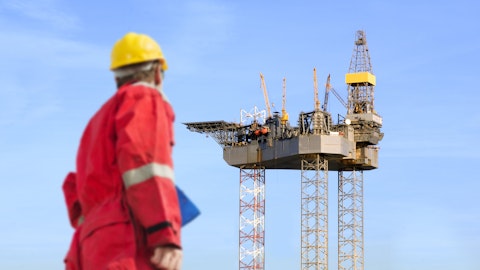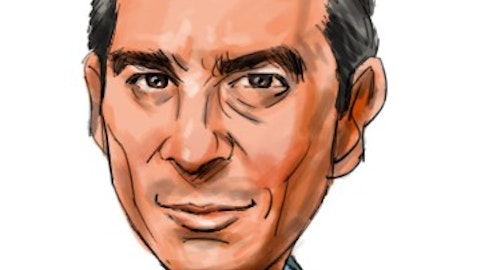The ten S&P 500 companies that have increased their dividend payout by the highest average annual rate during the last five years are analyzed in this article. The goal is to find out if they can continue their high dividend growth rate.
Since this article is designated to income-oriented investors, I have considered only stocks that are yielding more than 2.5%. The tables below show the top ten S&P 500 companies based on 5 year dividend growth, as well as each one’s:
– Dividend yield
– Payout ratio
– Average annual dividend growth rates during the last five and three years

Data: Portfolio123 (05/01/2016)
When a company has a long-term track record of consistent and rising dividend payments, it is a clear indicator that the company’s financial position is good.
Investing in companies that regularly raise dividends provides security in an uncertain market and means higher returns ahead.
I consider that besides dividend yield, the consistency and the rate of raising dividend payments are the most crucial factors for dividend-seeking investors.
Peter Lynch, the legendary manager of the Fidelity Magellan Fund, wrote in his book “Beating the Street”:
“The Dividend Achievers Handbook is one of my favorite bedside thrillers. Here’s a simple way to succeed in Wall Street: Buy the stocks on Mergent’s list and stick with them as long as they stay on the list.”
Dividend Achievers are stocks with 10+ consecutive years of dividend increases. Click here to see a list of all Dividend Achievers.
Seagate Technology PLC (NASDAQ:STX)
Seagate Technology PLC (NASDAQ:STX) designs, manufactures, and sells electronic data storage products. The company offers hard disk drives, solid state hybrid drives, and solid state drives, which are designed for enterprise servers, mainframes, and workstations; for desktop and notebook computers; and for various end user devices, such as digital video recorders, gaming consoles, personal data backup systems, portable external storage systems, and digital media systems. The company was founded in 1979 and is headquartered in Dublin, Ireland.

Image Source: Seagate Technology
On April 29, Seagate Technology PLC (NASDAQ:STX) reported its third quarter fiscal 2016 financial results, which missed earnings-per-share expectations by a significant margin of $0.15 (40.5%). The company posted revenue of $2.6 billion in the period, matching Street forecasts.
However, it projected fourth-quarter revenue of $2.3 billion, below the average analyst estimate of $2.61 billion. It was the first time in its last nine quarters where Seagate missed estimates, as shown in the table below.

Source: Yahoo Finance
The company’s Board of Directors has approved a quarterly cash dividend of $0.63 per share, which will be payable on May 24, 2016, to shareholders of record as of the close of business on May 10, 2016. During the third quarter, the company generated approximately $205 million in operating cash flow and paid cash dividends of $188 million.
Seagate has been paying dividends since 2003 but had stopped its payments in 2009 and 2010. On October 21, 2015, Seagate increased its quarterly dividend by 17% to $0.63 per common share. The forward annual dividend yield is very high at 11.58%, and the payout ratio is very high at 225%. The annual rate of dividend growth over the past three years was high at 33.6%, over the past five years was very high at 83.7%, and over the last ten years was at 22.9%.
However, the company said that the payment of any future quarterly dividends will be at the discretion of the Board and will be dependent upon Seagate’s financial position, results of operations, available cash, cash flow, capital requirements and other factors deemed relevant by the Board of Directors.
Considering the company’s very high payout ratio, I do not believe that it will raise its dividend payment. Moreover, the management’s cautious statement about the future quarterly dividends makes me think that even the current quarterly dividend is not sustainable.
Follow Seagate Technology Holdings Plc (NASDAQ:STX)
Follow Seagate Technology Holdings Plc (NASDAQ:STX)
Host Hotels and Resorts Inc (NYSE:HST)
Host Hotels and Resorts Inc (NYSE:HST) is a publicly owned real estate investment trust (REIT). The company primarily engages in the ownership and operation of hotel properties. It invests in the real estate markets of United States. It also invests in Canada, Mexico, Chile, the United Kingdom, Italy, Spain, and Poland. The firm primarily invests in luxury and upper upscale hotels. It was formerly known as Host Marriott Corporation. The company was founded in 1927 and is based in Bethesda, Maryland.

Image Source: Host Hotels & Resorts
On April 29, Host Hotels and Resorts Inc (NYSE:HST) reported its first quarter 2016 financial results, which beat EPS expectations by $0.03 (7.9%). The company posted revenue of $1.34 billion in the period, falling short of Street forecasts of $1.36 billion. HST showed earnings per share surprise in its three last quarters, as shown in the table below.

Data: Yahoo Finance
Host Hotels paid a regular quarterly cash dividend of $0.20 per share on its common stock on April 15, 2016, to stockholders of record as of March 31, 2016. The annual dividend yield is very high at 5.06%, and the payout ratio is pretty high at 116%. The annual rate of dividend growth over the past three years was high at 33.6%, over the past five years was very high at 83.2%, and over the last ten years was at 7.1%.
CEO Edward Walter said in the report that the company remains committed to its long-term goal of returning value to its stockholders through consistently strong dividends and stock repurchases. According to the company, it continues to make significant progress toward its asset sale goals and expects continued improvement in its operational and financial performance throughout the remainder of the year.
Since its year-end 2015 earnings call on February 17, 2016, the company has distributed $230 million of capital to its stockholders through dividends and stock buybacks. Year-to-date, the company repurchased 5.1 million shares at an average price of $16.08 for a total purchase price of approximately $81 million.
The company has a strong balance sheet, and it continues to execute on its strategic plan of reallocating capital out of markets where it expects lower growth or higher capital expenditure requirements. As such, and due to its commitment to its long-term goal of returning value to its stockholders, I believe that the future quarterly dividend is sustainable. However, I doubt that it can maintain such a high dividend growth rate because of the high payout ratio.
Follow Host Hotels & Resorts Inc. (NYSE:HST)
Follow Host Hotels & Resorts Inc. (NYSE:HST)
CF Industries Holdings, Inc. (NYSE:CF)
CF Industries Holdings, Inc. (NYSE:CF) manufactures and distributes nitrogen and phosphate fertilizer products worldwide. CF Industries was founded in 1946 and is based in Deerfield, Illinois.
CF Industries Holdings, Inc. (NYSE:CF) has been paying uninterrupted dividends since 2005. The annual dividend yield is at 3.63%, and the payout ratio is only 40.3%. The annual rate of dividend growth over the past three years was high at 55.4%, over the past five years was very high at 71.9%, and over the last ten years was also very high at 76.9%. However, the company has not raised its quarterly dividend since August 2014.
Since the payout ratio is low, I believe that the future quarterly dividend is sustainable. However, as I see it, the company would not keep its high five years dividend growth rate in the foreseeable future due to relatively low prices for nitrogen and phosphate fertilizer products.
Follow Cf Industries Holdings Inc. (NYSE:CF)
Follow Cf Industries Holdings Inc. (NYSE:CF)
Helmerich & Payne, Inc. (NYSE:HP)
Helmerich & Payne (HP) is a contract drilling company headquartered in Tulsa, Oklahoma, and engaged primarily in the drilling of oil and gas wells for exploration and production companies. The Company stands as one of the primary land and offshore platform drilling contractors in the world and is an industry leader in innovation.
Helmerich & Payne pays a generous dividend, currently yielding 4.16% the highest yield among its peer group, but the payout ratio is pretty high at 126.8%. The annual rate of dividend growth over the past three years was extremely high at 114.1%, over the past five years was also very high at 67.3%, and over the last ten years was at 32.5%.
Despite very low oil and gas prices that forced the company’s customers to reduce their drilling budgets, Helmerich & Payne, Inc. (NYSE:HP) has been able to generate positive free cash flow. The company has strong balance sheet, its quick ratio is very high at 3.30, and its debt to equity ratio is very low at 0.11.
According to the company, its strong liquidity position, along with its firm backlog of long-term contracts and reduced capital expenditures requirement, is expected to allow it to sustain its regular dividend dollar per share levels, and its intent is to continue with that plan. As such, in my view, the future quarterly dividend is sustainable. However, the company would not keep its high five years dividend growth rate while oil prices remain low.
Follow Helmerich & Payne Inc. (NYSE:HP)
Follow Helmerich & Payne Inc. (NYSE:HP)
Fifth Third Bancorp (NASDAQ:FITB)
Fifth Third Bancorp (NASDAQ:FITB) is a diversified financial services company headquartered in Cincinnati, Ohio. It operates through four segments: Commercial Banking, Branch Banking, Consumer Lending, and Investment Advisors.
The company has strong capital ratios, and ratios remained strong during the recent quarter. The common equity Tier 1 ratio was 9.81 percent, the tangible common equity to tangible assets ratio was 8.55 percent and 8.97 percent. The Tier 1 risk-based capital ratio was 10.91 percent, the total risk-based capital ratio was 14.66 percent, and the Leverage ratio was 9.57 percent.
Fifth Third entered into or completed multiple share repurchases during the last quarter. In total, common shares outstanding decreased by approximately 15 million shares in the first quarter of 2016 from the fourth quarter of 2015.
Fifth Third Bancorp (NASDAQ:FITB) has been paying uninterrupted dividends since 1990. The annual dividend yield is at 2.84%, and the payout ratio is only 29%. The annual rate of dividend growth over the past three years was at 15.2%, and over the past five years was very high at 67%.
Since the company has strong capital ratios and the payout ratio is low, I believe that the future quarterly dividend is sustainable. However, as I see it, the company would not keep its high five years dividend growth rate of 67% but would rather increase its dividend by a lower rate of about 15%, as it has done during the last three years.
Follow Fifth Third Bancorp (NASDAQ:FITB)
Follow Fifth Third Bancorp (NASDAQ:FITB)
Cisco Systems, Inc. (NASDAQ:CSCO)
On February 10, along its second quarter fiscal 2016 earnings report, Cisco (CSCO) has also declared a quarterly dividend of $0.26 per common share, a 24% or five-cent increase over the previous quarter’s dividend. Cisco’s board of directors has also approved a $15 billion increase to the authorization of the stock repurchase program. Cisco’s board had previously authorized up to $97 billion in stock repurchases.
There is no fixed termination date for the repurchase program. The remaining authorized amount for stock repurchases under this program, including the additional authorization, is approximately $16.9 billion. In the report, Kelly Kramer, Cisco executive vice president and chief financial officer, said that Cisco Systems, Inc. (NASDAQ:CSCO) remains committed to its shareholders in delivering profitable growth and returning a minimum of 50 percent of its free cash flow back annually.
Cisco Systems, Inc. (NASDAQ:CSCO) has been paying uninterrupted dividends since 2011. The annual dividend yield is pretty high at 3.78%, and the payout ratio is only 41.3%. The annual rate of dividend growth over the past three years was high at 41.9%, and over the past five years was very high at 60.7%. Cisco is generating strong free cash flow; total cash flow from operating activities in the last quarter was at $3,922 million, and capital expenditures were only $314 million, what made the free cash flow an impressive $3,608 million. As such, and because the company is committed to returning a minimum of 50 percent of its free cash flow back annually, I believe that Cisco will continue to grow its dividend at about the same very high rate.
Follow Cisco Systems Inc. (NASDAQ:CSCO)
Follow Cisco Systems Inc. (NASDAQ:CSCO)
Iron Mountain Inc (NYSE:IRM)
Iron Mountain Inc (NYSE:IRM) is a global leader in enterprise storage with a high-return, real estate-based business model, yielding over $3 billion of revenues annually. The company provides storage and information management services to a high-quality, diversified customer base across numerous industries and government organizations. Iron Mountain serves more than 170,000 customers, including approximately 94% of the Fortune 1000, and no single customer accounts for more than 1% of revenues.
Iron Mountain Inc (NYSE:IRM) provides storage and information management services in 41 countries on six continents, storing 530 million cubic feet of records in a portfolio of approximately 1,100 facilities containing 70 million square feet of space. The company was founded in 1951 and is headquartered in Boston, Massachusetts.

Image Source: Iron Mountain
On April 28, Iron Mountain reported its first quarter 2016 financial results, which beat EPS expectations by $0.04 (7.9%). In the report, the company said that year-over-year dividend growth of 2.0% per share expected in 2016. IRM showed earnings per share surprise in its three last quarters, as shown in the table below.

Data: Yahoo Finance
Iron Mountain has been paying uninterrupted dividends since 2010. The annual dividend yield is high at 5.31%, and the payout ratio is very high at 282%. The annual rate of dividend growth over the past three years was at 22.5%, and over the past five years was very high at 59.1%. Since the company said that it expects year-over-year dividend growth of 2.0%, it is quite clear that it would not keep its high five years dividend growth rate of 59%.
Follow Iron Mountain Inc (NYSE:IRM)
Follow Iron Mountain Inc (NYSE:IRM)
Viacom, Inc. (NASDAQ:VIAB)

Image Source: Viacom
On April 28, Viacom (VIAB) reported its second quarter fiscal 2016 financial results, which beat EPS expectations by $0.02 (2.7%). The company posted revenue of $3.0 billion in the period, just above $2.98 billion consensus. Viacom, Inc. (NASDAQ:VIAB) showed earnings per share surprise in most of its last quarters, as shown in the table below.

Data: Yahoo Finance
Viacom, Inc. (NASDAQ:VIAB) has been paying uninterrupted dividends since July 2010, and it increased its quarterly dividend per share in the fiscal fourth quarter of each fiscal year. The forward annual dividend yield is pretty high at 3.91%, and the payout ratio is only 27.3%. The annual rate of dividend growth over the past three years was at 10.7%, and over the past five years was very high at 56.1%. Although the payout ratio is low, in my opinion, the company will continue to raise its dividend by an average annual rate of about 10%, as it has done in the last three years and not by the very high rate of about 56%.

Source: 2nd Quarter ’16 Earnings Presentation
Follow Viacom Inc.
Follow Viacom Inc.
Amgen, Inc. (NASDAQ:AMGN)
On April 28, Amgen (AMGN), the world’s largest biotech drugmaker, reported its first quarter 2016 financial results, which beat EPS expectations by a significant margin of $0.30 (11.5%). The company posted revenue of $5.53 billion in the period, also exceeding Street forecasts of $5.36 billion. The company showed earnings per share surprise in all its last eight quarters, as shown in the table below.

Data: Yahoo Finance
Amgen, Inc. (NASDAQ:AMGN) started to pay a dividend in August 2011. In February, the company increased its dividend to $1 per share, an increase of 27% of last year. The forward annual dividend yield is at 2.53%, and the payout ratio is only 34.5%. The annual rate of dividend growth over the past three years was high at 30%, and over the past five years was very high at 54.1%.
The company generated $1.8 billion of free cash flow in the first quarter of 2016 versus $1.4 billion in the first quarter of 2015 driven by higher revenues and higher operating income. During the first quarter, the company repurchased 4.7 million shares of common stock at a total cost of $690 million. At the end of the first quarter, Amgen had $4.2 billion remaining under its stock repurchase authorization.
According to the company, it has designed its capital allocation strategy to deliver value to shareholders through both an attractive return of capital and dividends and buybacks and vigorous investment for long-term growth. Amgen, Inc. (NASDAQ:AMGN) also said that this is an exciting time in the field of biology with promising clinical opportunities and breakthroughs arising in many of its areas of interest. As such, in my opinion, Amgen could continue to raise its dividend by a very high rate as it has done in the last few years.
Follow Amgen Inc (NASDAQ:AMGN)
Follow Amgen Inc (NASDAQ:AMGN)
Valero Energy Corporation (NYSE:VLO)

Image Source: Valero
On January 21, Valero (VLO), the world’s largest independent petroleum refiner and marketer, announced a 20% increase in its quarterly common stock dividend from $0.50 per share to $0.60 per share. The annual dividend yield is pretty high at 4.08% and the payout ratio only 21.2%. The annual rate of dividend growth over the past three years was very high at 37.8%, and over the past five years was also very high at 53.4%,
Valero Energy Corporation (NYSE:VLO) paid $240 million in dividends and purchased 11.1 million shares of its common stock for $767 million in the last quarter, resulting in total cash returned to stockholders of $1 billion in the fourth quarter of 2015. In 2015, Valero returned $3.7 billion to stockholders, or 80% of adjusted net income from continuing operations attributable to Valero stockholders, consisting of $848 million in dividends and $2.8 billion in stock buybacks.
The company is generating strong free cash flow; its price to free cash flow ratio is only 9.10, and it is targeting a payout ratio of 75% of net income in 2016. As such, in my opinion, Valero could continue to raise its dividend by a very high rate as it has done in the last few years.
Follow Valero Energy Corp (NYSE:VLO)
Follow Valero Energy Corp (NYSE:VLO)
Final Thoughts
The average annual rate of dividend increase of the ten S&P 500 companies that have raised their dividend payout by the highest rate during the last five years has been very high at about 66%.
However, as I see it, only three companies; Cisco, Amgen, and Valero among the ten dividend growers could continue to raise their dividend by a very high rate as they have done in the last few years.
The fact that a company has raised its dividend by a very high rate during the last few years does not guarantee a continuous dividend increase by the same rate. Nevertheless, in my opinion, the actual dividend payment is sustainable for all the companies in the group except Seagate Technology.
Disclosure: This article is originally published on Sure Dividend by Arie Goren.





